Nadar
Gaspard-Félix Tournachon (5 April 1820 – 20 March 1910[1]), known by the pseudonym Nadar, was a French photographer, caricaturist, journalist, novelist, balloonist, and proponent of heavier-than-air flight. In 1858, he became the first person to take aerial photographs.[2]
Nadar | |
|---|---|
 Self-portrait of Nadar, c. 1860 | |
| Born | Gaspard-Félix Tournachon 5 April 1820 Paris, France |
| Died | 20 March 1910 (aged 89) Paris, France |
| Resting place | Père Lachaise Cemetery 48.860°N 2.396°E |
| Occupations |
|
| Known for | Pioneer in photography |
| Parent |
|
| Signature | |
Photographic portraits by Nadar are held by many of the great national collections of photographs. His son, Paul Nadar (1856–1939), continued the studio after his death.
Life
Gaspard-Félix Tournachon (also known as Nadar)[3] was born in early April 1820 in Paris,[4] though some sources state he was born in Lyon. His father, Victor Tournachon, was a printer and bookseller. Nadar began to study medicine but quit for economic reasons after his father's death.[5][4]
Nadar started working as a caricaturist and novelist for various newspapers. He fell in with the Parisian bohemian group of Gérard de Nerval, Charles Baudelaire, and Théodore de Banville. His friends picked a nickname for him, perhaps by a playful habit of adding "dar" to the end of words, Tournadar, which later became Nadar.[5] His work was published in Le Charivari for the first time in 1848. In 1849, he founded La Revue Comique à l'Usage des Gens Sérieux. He also edited Le Petit Journal pour Rire.[4]
From work as a caricaturist, he moved on to photography. He took his first photographs in 1853, and in 1854 opened a photographic studio at 113 rue St. Lazare.[5] He moved to 35 Boulevard des Capucines in 1860. Nadar photographed a wide range of personalities: politicians (Guizot, Proudhon), stage actors (Sarah Bernhardt, Paulus), writers (Hugo, Baudelaire, Sand, Nerval, Gautier, Dumas), painters (Corot, Delacroix, Millet), and musicians (Liszt, Rossini, Offenbach, Verdi, Berlioz).[5] Portrait photography was going through a period of native industrialization, and Nadar refused to use the traditional sumptuous decors; he preferred natural daylight and despised what he considered to be unnecessary accessories. In 1886, with his son Paul, he did what may be the first photo-report: an interview with the great scientist Michel Eugène Chevreul, who at the time was 100 years old.[6] It was published in Le Journal Illustré.[5]
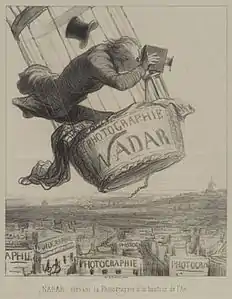 Nadar élevant la Photographie à la hauteur de l'Art ("Nadar elevating Photography to Art"). Lithograph by Honoré Daumier, appearing in Le Boulevard, 25 May 1863
Nadar élevant la Photographie à la hauteur de l'Art ("Nadar elevating Photography to Art"). Lithograph by Honoré Daumier, appearing in Le Boulevard, 25 May 1863._-_D%60apr%C3%A8s_les_renseignements_fournis_par_M._Nadar._Gravure_1863.jpg.webp) 1863: Disaster with Le Géant at Neustadt am Rübenberge at Hanover. Illustration in a newspaper
1863: Disaster with Le Géant at Neustadt am Rübenberge at Hanover. Illustration in a newspaper.jpg.webp) Nadar (Gaspard-Félix Tournachon) c. 1863, studio portrait, carte-de-visite
Nadar (Gaspard-Félix Tournachon) c. 1863, studio portrait, carte-de-visite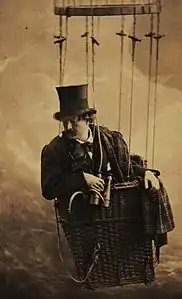 Studio portrait of Nadar in a balloon basket, c. 1863
Studio portrait of Nadar in a balloon basket, c. 1863
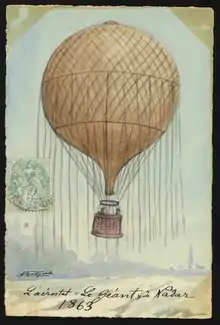
In 1858, he became the first person to take aerial photographs. This was done using the wet plate collodion process, and since the plates had to be prepared and developed (a process that required a chemically neutral setting) while the basket was aloft, Nadar experienced imaging problems as gas escaped from his balloons. After Nadar invented a gas-proof cotton cover and draped it over his balloon baskets, he was able to capture stable images.[7]: 159 He also pioneered the use of artificial lighting in photography, working in the catacombs of Paris. He was thus the first person to photograph from the air with his balloons, as well as the first to photograph underground, in the Catacombs of Paris.[4] In 1867, he published the first magazine to focus on air travel: L'Aéronaute.[4]
In 1863, Nadar commissioned the prominent balloonist Eugène Godard to construct an enormous balloon, 60 metres (196 ft) high and with a capacity of 6,000 m3 (210,000 cu ft), and named Le Géant (The Giant).[7]: 164 On his visit to Brussels with Le Géant, on 26 September 1864, Nadar erected mobile barriers to keep the crowd at a safe distance. Crowd control barriers are still known in Belgium as Nadar barriers.[4] Le Géant was badly damaged at the end of its second flight, but Nadar rebuilt the gondola and the envelope, and continued his flights. In 1867, he was able to take as many as a dozen passengers aloft at once, serving cold chicken and wine.[8]
For publicity, he recreated balloon flights in his studio with his wife, Ernestine, using a rigged-up balloon gondola.[9] He stayed a passionate aeronaut until he and Ernestine were injured in an accident in Le Géant.[10]

Le Géant (The Giant) inspired Jules Verne's Five Weeks in a Balloon. Nadar was the inspiration for the character of Michael Ardan in Verne's From the Earth to the Moon.[7]: 164 [11][5] In 1862, Verne and Nadar established a Société pour la recherche de la navigation aérienne, which later became La Société d'encouragement de la locomotion aérienne au moyen du plus lourd que l'air (The Society for the Encouragement of Aerial Locomotion by Means of Heavier than Air Machines).[8]: 123 Nadar served as president and Verne as secretary.[12]
During the Siege of Paris in 1870–71, Nadar was instrumental in organising balloon flights carrying mail to reconnect the besieged Parisians with the rest of the world, thus establishing the world's first airmail service.[7]: 260 [5][8]
In April 1874, he lent his photo studio to a group of painters to present the first exhibition of the Impressionists.[13] He photographed Victor Hugo on his death-bed in 1885.[14] He is credited with having published (in 1886) the first photo-interview (of famous chemist Michel Eugène Chevreul, then a centenarian).[6] His photographs of women are notable for their natural poses and individual character.[15] Nadar was recognized for breaking the conventions of photographic portrait, choosing to capture the subjects as active participants.[16]
As of 1 April 1895, Nadar turned over the Paris Nadar Studio to his son Paul. He moved to Marseille, where he established another photography studio in 1897. On 3 January 1909 he returned to Paris.[17]
Nadar died on 20 March 1910, age 89. He was buried in Père Lachaise Cemetery in Paris. The studio continued under the direction of his son and long-term collaborator, Paul Nadar (1856–1939).[18]
Works
Towards the end of his life, Nadar published Quand j'étais photographe, which was translated into English and published by MIT Press in 2015. The book is full of both anecdotes and samples of his photography, including many portraits of recognizable names.[19][20]
The painter Jean-Auguste-Dominique Ingres sent some of his clients to Nadar to have their photographs taken as studies for his paintings.[21]
Gallery
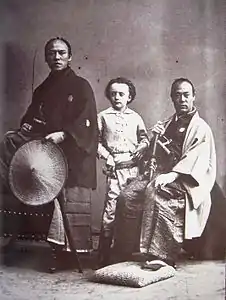 Nadar's son (center) with Yatsu Kanshiro (left) and an unnamed samurai (right), photographed by Nadar. They were members of the Second Japanese Embassy to Europe in 1863.
Nadar's son (center) with Yatsu Kanshiro (left) and an unnamed samurai (right), photographed by Nadar. They were members of the Second Japanese Embassy to Europe in 1863. Caricature of Balzac, 1850
Caricature of Balzac, 1850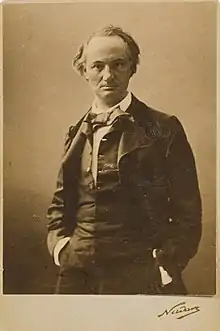 Charles Baudelaire, 1855
Charles Baudelaire, 1855 Sarah Bernhardt, c. 1864
Sarah Bernhardt, c. 1864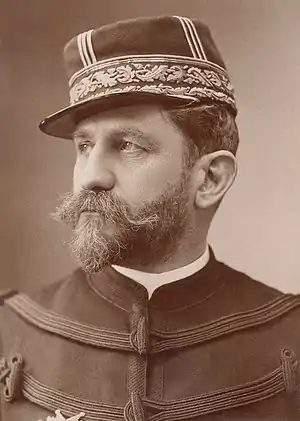
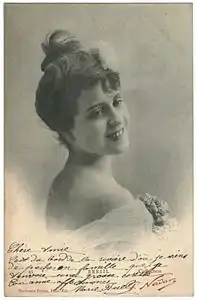 Marguerite Brésil
Marguerite Brésil Le Bris and his flying machine, Albatros II (could be misattributed, some sources say the photographer was Pépin fils)
Le Bris and his flying machine, Albatros II (could be misattributed, some sources say the photographer was Pépin fils)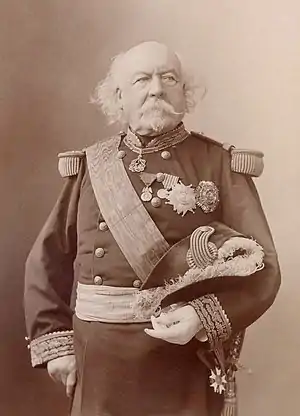

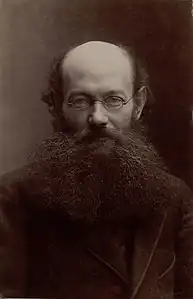
 Prince Adam Jerzy Czartoryski
Prince Adam Jerzy Czartoryski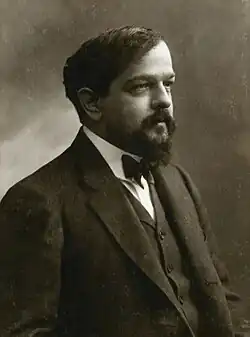
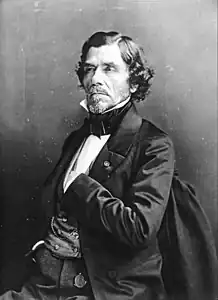
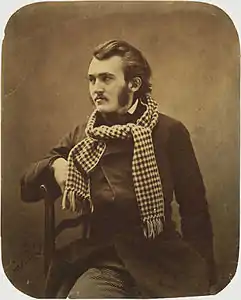 Gustave Doré, 1859
Gustave Doré, 1859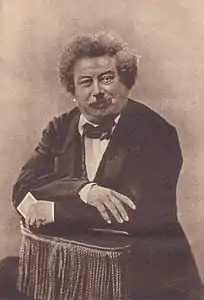

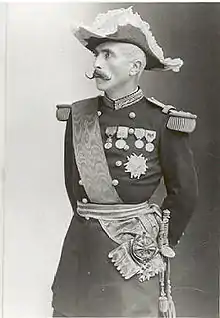 Marquis de Galliffet, the fusilleur de la Commune
Marquis de Galliffet, the fusilleur de la Commune_by_Nadar.jpg.webp) Charles Gounod in 1890
Charles Gounod in 1890 Élisabeth de Gramont, 1889
Élisabeth de Gramont, 1889
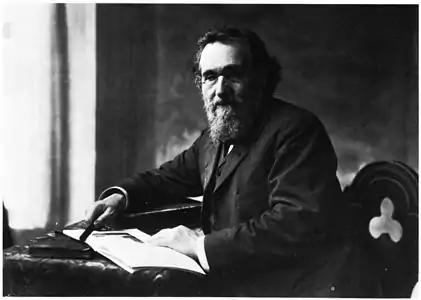
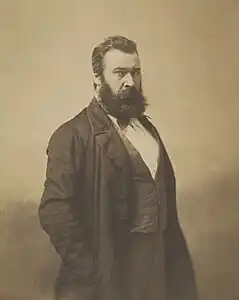
 Nasser al-Din Shah Qajar, king of Persia 1848–1896
Nasser al-Din Shah Qajar, king of Persia 1848–1896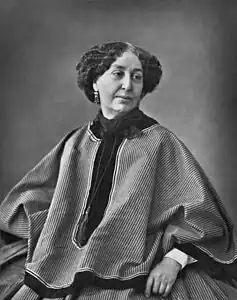 George Sand, 1864
George Sand, 1864.jpg.webp)
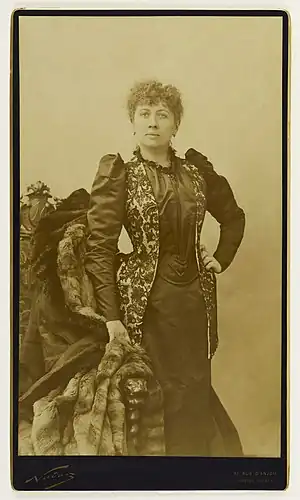 Séverine, c. 1895
Séverine, c. 1895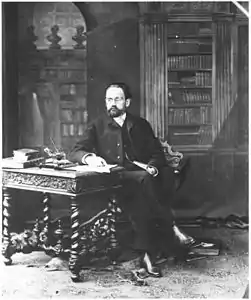 Émile Zola, 1895
Émile Zola, 1895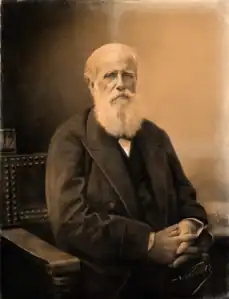
See also
- Prix Nadar, French photojournalism prize given in Nadar's name
- Mononymous person, a person known with only one word
- Michel Ardan, a character from the 1865 novel From the Earth to the Moon who was inspired by Nadar
References
- "La Mort de Nadar". l'Aérophile (in French): 194. 1 April 1910.
- "These Incredible Images Show How Aerial Photography Has Developed". Time. Retrieved 17 July 2022.
- Jenner, Greg (19 March 2020). Dead Famous: An Unexpected History of Celebrity from Bronze Age to Silver Screen. Orion. p. 213. ISBN 978-0-297-86981-8.
- "Félix Nadar Gaspard-Félix Tournachon (6 April 1820 – 23 March 1910, France)". Lambiek Comiclopedia. Retrieved 12 November 2019.
- "Archives de France |". www.archivesdefrance.culture.gouv.fr (in French). Retrieved 15 October 2015.
- ""Le Journal Illustré" Publishes the First Photo-Interview 9/5/1886". History of Information. Retrieved 12 November 2019.
- Holmes, Richard (2013). Falling upwards : how we took to the air. London: HarperPress. ISBN 978-0-00-738692-5.
- Hallion, Richard P (2003). Taking Flight: Inventing the Aerial Age, from Antiquity through the First World War. Oxford University Press. p. 71-73. ISBN 0-19-516035-5.
- Nadar with His Wife, Ernestine, in a Balloon, www.metmuseum.org
- Nadar, britannica.com.
- Holmes, Richard (24 May 2018). "Luftmensch in Paris". The New York Review of Books. ISSN 0028-7504.
- Miller, Roland (18 January 2016). Abandoned in place : preserving America's space history. University of New Mexico Press. p. 3. ISBN 978-0826356253. Retrieved 12 November 2019.
- Gersh-Nesic, Beth (23 September 2019). "How the First Impressionist Exhibition Came to Be". Thought Co. Retrieved 12 November 2019.
- "Victor Hugo on his Death Bed". Philadelphia Museum of Art. Retrieved 12 November 2019.
- Hambourg, Maria Morris (1995). Nadar. Metropolitan Museum of Art. pp. 50–51. ISBN 9780810964891. Retrieved 12 November 2019.
- Smith, Ian Haydn (2018). The short story of photography : a pocket guide to key genres, works, themes & techniques. London: Laurence King Publishing. ISBN 978-1-78627-201-0. OCLC 1002114117.
- Nadar, Félix (6 November 2015). When I Was a Photographer. Translated by Cadava, Eduardo; Theodoratou, Liana (1st English translation ed.). MIT Press. pp. 234–235. ISBN 9780262330725. Retrieved 12 November 2019.
- "Paul Nadar", Getty Museum
- Adam Begley, "The absurd life of Félix Nadar, French portraitist and human flight advocate", The Guardian, 23 December 2015.
- Begley, Adam (11 July 2017). The Great Nadar: The Man Behind the Camera. New York: Tim Duggan Books. ISBN 978-1-101-90260-8.
- De la Croix, Horst; Tansey, Richard G.; Kirkpatrick, Diane (1991). Gardner's Art Through the Ages (9th ed.). Thomson/Wadsworth. p. 910. ISBN 0-15-503769-2.
External links
- Works by Nadar at Project Gutenberg
- Works by or about Nadar at Internet Archive
- 1867 Caricature of Nadar by André Gill
- Article about Nadar by Bruce Sterling
- Article about Nadar by Roger Cicala
- Fostinum: Nadar numerous photographs by Nadar
- Nadar at Find a Grave
